印度税法对折旧的相关规定简介
印度的税收征管问题
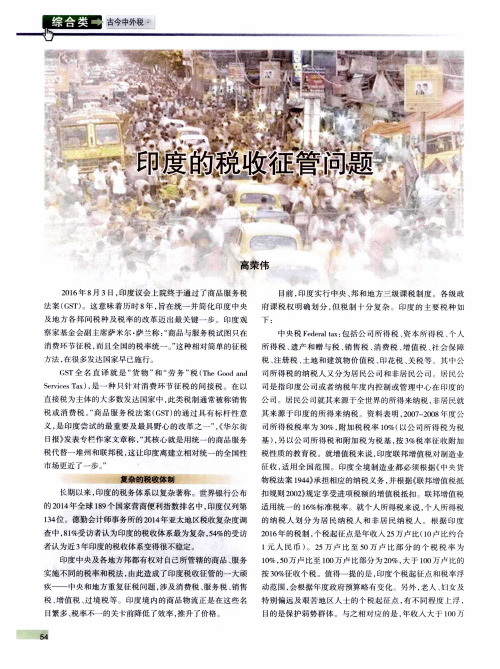
长期以来 , 印度的税务体系以复杂著称。世界银行公布 扣规则2 0 0 2 ) ) 规定享受进项税额的增值税抵扣 。联邦增值税 的2 0 1 4 年全球 1 8 9 个 国家营商便利指数排名中, 印度仅列第 适 用 统一 的 1 6 %标准 税 率 。就个 人所 得 税来 说 , 个 人所 得 税 1 3 4 位。德勤会计师事务所的2 0 1 4 年亚太地区税收复杂度调
司所 得 税 的纳 税 人 又分 为 居 民公 司 和 非居 民公 司 错 民 公 司是 指 印度 公 司或 者纳 税 年度 内控 制 或管 理 中心 在 印 度 的
G S T全 名 直译 就 n d a n d S e r v i c e s T a x ) , 是一 种 只钳‘ 对 消 费环 节 征 税 的 间接 税 。在 以
高荣伟
2 0 1 6 年8 月 3日, 印 度议 会 上院终 于通 过 了商 品 服务 税 法案( G S T) 。这 意味 着 历 时 8 年, 旨在统 一 并 简 化 印度 中央
目前 , 印度实行 中央 、 邦和地方三级课税制度 。各级政
府 课 税 权 明确 划 分 , 但 税 制 十 分 复 杂 . 印 度 的 主 要 税 种 如
直接 税 为 主体 的大 多数 发 达 国家 中 , 此类 税 制通 常被 称销 售
公 司 。居 民公 司就 其来 源 于全世 界 的所 得来 纳税 , 非 居 民就
税或消费税。 “ 商 品服 务 税 法 案 ( G S T) 的 通过 具有 标 杆 性 意 其 来 源 于 印度 的 所得 来 纳 税 、资料 表 明 . 2 0 0 7 — 2 0 0 8 年 度 公 义, 是 印度 尝 试 的最 重要 及 最具 野 心 的改 革 之 一 ” , 《 华尔 街 日报 》 发 表专 栏作 家 文章 称 , “ 其 核心 就是 用统 一 的商 品服 务 司所 得 税 税 率 为 3 0 %, 附 加 税税 率 1 0 %( 以 公 司所 得 税 为税 基) , 另 以公 司所 得 税 和 附加 税 为税 基 , 按3 %税 率 , 征 收 附加
印度税收简介

印度税收简介印度是以间接税为主的国家。
现行的主要税种有公司所得税、个人所得税、增值税、消费税、服务税、最低选择税、预提税、财富税等。
(一)主要税种1.公司所得税(1)纳税人公司所得税的纳税人分为居民公司和非居民公司。
居民公司是指印度公司或者纳税年度控制或管理中心完全位于印度的公司。
不符合上述条件的公司是非居民公司。
(2)征税对象、税率居民公司就来源于全世界的所得纳税;非居民公司就来源于印度的所得纳税。
印度公司在2004年3月31日结束的纳税年度适用的公司所得税税率为35.875%(含2.5%的附加税)。
外国公司按“预提税”规定的税率纳税。
资本利得适用的税率较为复杂。
购置资产在3年(股份、上市证券、某些共同基金或印度投资公司产品为1年)出售实现的利得为短期资本利得,按经营所得适用税率征税。
外国公司转让印度公司的股份或债券,按购买时所用外币计算(不经通货膨胀调整),但纳税时应折合成卢比,短期资本利得按41%的税率纳税,长期资本利得按20.5%的税率纳税。
出售在印度上市的证券取得长期资本利得,纳税人可以选择经通货膨胀调整后按20.5%的税率纳税,或选择不经通货膨胀调整而适用10.25%的税率。
海外金融机构(或离岸基金)转让用外币购买的某些共同基金或印度投资公司的产品取得长期资本利得,以及非居民转让债券取得长期资本利得, 应就毛收入按10.25%的税率纳税。
外国机构投资者投资印度资本市场,取得短期资本利得按30.75%的税率纳税,取得长期资本利得按10.25%的税率纳税。
出售政府批准的从事某些基础设施建设的企业的股份,取得长期资本利得,符合规定条件时可以免税。
出售折旧资产取得的利得和亏损属于短期资本利得或亏损,按经营所得的税率纳税。
在股息和利息方面, 国公司从2003年4月1日起分配或支付股息的,应按12.8125%的税率缴纳股息分配税。
非居民用外币购买印度公司(根据印度政府指南)在海外发行的债券取得的利息,应就毛收入按10.25%的税率纳税。
印度税法体系

• 支付时就从款项中预扣
二、企业所得税
• 预扣所得税(TDS)
• 税率
收入类型
居股息
0
20%
0
利息
10%
20%
20%
支付给承包商的款项 2%
20%
10%
设备/房产租金
2%/10%
20%
40%
技术服务/特许权
10%
20%
10%
常住居民
О
非常住居民
Х
О
О
非居民
Х
О
Х
三、个人所得税
• 个人所得税税率
净收入范围(60 净收入范围(60 或
岁以下)
以上,80岁以下)
净收入范围
所得税税率
(80 岁或以上)
0-25 万卢比
0-30 万卢比
0-50 万卢比
0
25 万-50 万卢比 30 万-50 万卢比
-
10%
50 万-100 万卢比 50 万-100 万卢比
3%
3%
3%
3%
SAD
4.00% 4.00% 4.00% 4.00% 4.00% 4.00% 4.00%
∑
26.43% 29.44% 23.42% 29.44% 17.39% 29.44% 14.71%
七、消费税和其他税种
• 中央消费税( Central excise duty,CST )
印度生产,最终在印度消费的商品
二、企业所得税
• 常设机构PE(permanent establishment)
• 常设机构认定: 3、服务型(劳务型)常设机构 企业通过雇员或者其他人员,在印度提供特许 权使用费和技术服务费所规定的技术服务以外 的劳务连续或累计超过183 天
税法规定折旧年限
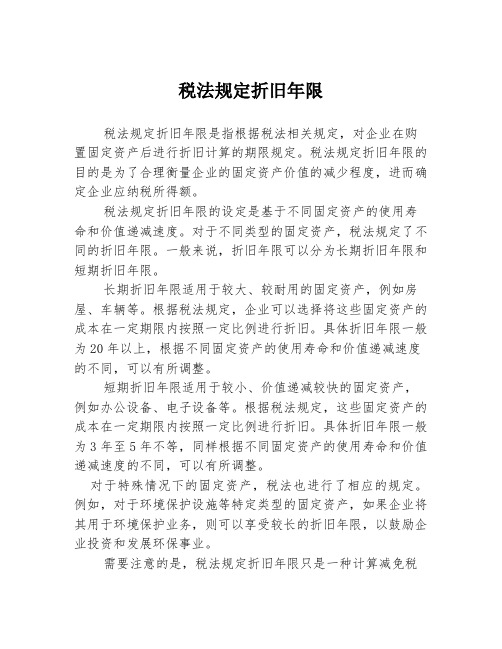
税法规定折旧年限税法规定折旧年限是指根据税法相关规定,对企业在购置固定资产后进行折旧计算的期限规定。
税法规定折旧年限的目的是为了合理衡量企业的固定资产价值的减少程度,进而确定企业应纳税所得额。
税法规定折旧年限的设定是基于不同固定资产的使用寿命和价值递减速度。
对于不同类型的固定资产,税法规定了不同的折旧年限。
一般来说,折旧年限可以分为长期折旧年限和短期折旧年限。
长期折旧年限适用于较大、较耐用的固定资产,例如房屋、车辆等。
根据税法规定,企业可以选择将这些固定资产的成本在一定期限内按照一定比例进行折旧。
具体折旧年限一般为20年以上,根据不同固定资产的使用寿命和价值递减速度的不同,可以有所调整。
短期折旧年限适用于较小、价值递减较快的固定资产,例如办公设备、电子设备等。
根据税法规定,这些固定资产的成本在一定期限内按照一定比例进行折旧。
具体折旧年限一般为3年至5年不等,同样根据不同固定资产的使用寿命和价值递减速度的不同,可以有所调整。
对于特殊情况下的固定资产,税法也进行了相应的规定。
例如,对于环境保护设施等特定类型的固定资产,如果企业将其用于环境保护业务,则可以享受较长的折旧年限,以鼓励企业投资和发展环保事业。
需要注意的是,税法规定折旧年限只是一种计算减免税额的方法,具体应用时还需按照税法的相关规定和会计准则进行具体操作。
此外,税法对于折旧年限的规定是基于一定的经济和税收政策考虑的,在实际操作中,企业可以根据自身情况和经济发展的需要进行调整和优化。
总之,税法规定折旧年限是为了合理确定企业的折旧计算期限。
根据税法规定,不同类型的固定资产有不同的折旧年限。
企业在计算折旧时,应根据税法规定和会计准则进行准确的操作,以确保计算结果的准确性。
最新的税法规定固定资产折旧率和使用年限,折旧方法

最新的税法规定固定资产折旧率和使用年限,折旧方法
税法对房屋、建筑物等固定资产计算折旧的最低年限,为20年。
新企业所得税法对固定资产折旧问题有两大变化,一是预计净残值,二是折旧年限。
它取消了老所得税法统一规定的按照固定资产原价5%预计净残值的规定,而是授权企业根据固定资产的性质和使用情况自主合理确定,但一经确定不得变更。
《企业所得税法实施条例》(以下简称《条例》)第五十九条规定:固定资产按照直线法计算的折旧,准予扣除。
企业应当自固定资产投入使用月份的次月起计算折旧;停止使用的固定资产,应当自停止使用月份的次月起停止计算折旧。
企业应当根据固定资产的性质和使用情况,合理确定固定资产的预计净残值。
固定资产的预计净残值一经确定,不得变更。
《条例》第六十条规定:除国务院财政、税务主管部门另有规定外,固定资产计算折旧的最低年限如下:
(一)房屋、建筑物,为20年;
(二)飞机、火车、轮船、机器、机械和其他生产设备,为10年;
(三)与生产经营活动有关的器具、工具、家具等,为5年;
(四)飞机、火车、轮船以外的运输工具,为4年;
(五)电子设备,为3年。
2018印尼税收袖珍指南-PwC

预提税
19
所得税法第21,22,4(2),23和26条
国际税收协定
25
避免双重征税协定;税收信息交换协议;
税收事务行政互助协议;多边工具;美国账户税务合规法案
增值税
33
概述;VAT免税;免征VAT优惠
奢侈品销售税
44
除车辆以外的应税商品;车辆
关税与消费税
46
进口关税;出口关税;消费税
税收优惠
49
所得税优惠;LST优惠;特殊项目与特定区域的
税务服务
2018 印尼税收袖珍指南
/id
目录
企业所得税
1
税率;纳税居民;纳税;营业利润;受控外国公司;资本补贴;
未准予扣除的项目;负债权益比率;亏损;利润分配;
认定利润;特殊行业及活动;转让定价
个人所得税
14
普通税率;优惠税率;主要个人减免项目;纳税居民;
登记与申报;纳税;实物福利;社会保障体系;
如果纳税年度内预缴的税额(所得税法第 22 条、第 23 条和第 25 条) 及在国外缴纳的税额(所得税法第 24 条)总额少于该年度应纳企业 所得税额,那么纳税企业需要在申报企业所得税之前补缴差额。补缴 的税额即为所得税法第 29 条。
纳税居民或外资常设机构所赚取的部分收入需缴纳最终所得税。由第 三方代扣代缴的税(即所得税法第 4 条第(2)款)构成了纳税居民 就该收入的最终所得税(请参考第 20-21 页关于应纳最终所得税法第 4 条第(2)款中的收入项目)。
纳税居民
在印尼注册或以印尼为公司住所地的公司会被视为印尼的纳税居民。 通过常设机构(PE)在印尼从事商业活动的外资企业,一般需要履行 与纳税居民相同的纳税义务。
纳税
关于在印尼如何避税的办法

关于在印尼如何避税的办法利润转移。
印尼没有外汇管制,投资者可自由地把资金转移到海外或从海外汇人到印尼。
有了公司,在印尼市场占赚取的利润,就可以合法地打回到中国境内,可以流动资金归还(不用纳所得税),或以工程租赁设备付给国内母公司租赁款(仅交10%所得税.大大低于正常的30%预交所得税)设备的进口税筹划。
印尼目前平均关税水平为7.3%。
中国公司为进行工程承包建设,需要从国内进口大型机械设备。
其永久性入关的税率平均如下:所得税2.5%,进项税10%,关税2.5%。
根据报关金额的15%一次性交纳进口环节的税,对进口商来说,是一个不小的负担,尤其占用流动资金,一些中国企业为此,压低报关价格,以为这样可以少交税,其实,将来投产后,由于报关价格低,相应的折旧也低,所得税就会多交,还有所交的税中,进项税是可以退回的,而所得税可以在年底时,抵交企业所得税,所以没有必要做假。
印尼实行预扣所得税的政策,每一笔收入的实现.需要交纳4.5%的预交所得税(prepaidpph),年末再进行汇算清缴,多退少补,但这一政策严重占用企业流动资金,同时,在退税过程非常繁琐,给企业以沉重的负担。
印尼的企业所得税计算方法与国内类似,即:(会计利润+/-纳税调整)*税率=年度应缴所得税,所得税率基本上为30%,实际上,这个税率也是超额累进的,只不过前两个税率对应的应纳税所得额比较小。
印尼的所得税分个人所得税和企业所得税两种,为累进制,采取自我评估法计算税款。
印尼对外国人投资事业所课征的公司税均与其国内企业相同。
税率为 : 应税收入2500万盾以下,税率10%;应税收入2500万盾以下,税率15%;应税收入5000万盾以上,税率30%。
印尼对股利、利息、权利金等的汇出课征留置税,税率均为20%。
这使得子公司在支付母公司的股利、贷款利息或技术权利金时,必须负担额外的税赋。
印尼长期以来对外汇进出甚少管制。
汇率采用浮动汇率制度。
印尼货币可自由兑换外币。
印度尼西亚税法简介

印尼税法简介印度尼西亚税法简介一、企业所得税(一)可税前扣除项目通常可税前扣除的成本包括生产经营成本、折旧及摊销、限额范围内的养老金及社会保险、销售或转让资产产生的亏损、汇兑亏损、研究开发成本及坏账。
除所得税外的其他税费成本可在所得税前扣除。
大部分利息可扣除,下列情况除外:超过债资比限额部分借款对应的利息不可扣除;将取得的贷款用于存款/储蓄支付的利息;将取得的贷款用于购买免税分红股份支付的利息。
特许权使用费可以扣除,但一个常设机构(PE)支付给其总机构的特许权使用费除外。
(二)不可税前扣除项目股息等形式的利润分配;股东个人费用;支付给股东或关联方超过合理水平的工作报酬。
企业所得税一般税率为25%。
二、预扣税/预提税(一)股息派发居民企业向境外股东分配的股息需缴纳20%的利润预提税,税收协定另有规定的除外。
居民企业向居民企业支付的股息需缴纳15%的最终预提所得税,在满足持股比例等条件时可以免税。
(二)利息居民企业向境外贷款人支付的利息需缴纳20%的最终预提所得税,税收协定另有规定的除外。
(三)其他任何对非居民收款人支付的服务费(购买商品除外),通常均需缴纳20%预扣税,但可依据税收协定(DTA)决定是否可予以减免。
三、增值税(一)应税范围增值税应税范围包括:在印度尼西亚境内销售应税商品及提供应税劳务、进口商品、使用进口的无形应税商品或劳务;总公司分支机构需分别登记注册为增值税纳税人。
(二)进口进口货物按照到岸价(含进口关税)征收10%增值税;政府为接受国外资助的政府项目减免增值税。
(三)税收优惠(四)关税进口关税,不同商品根据不同关税税率对其到岸价(CIF)计算决定,范围在0%至170%之间。
一般工业产品的税率在5%至10%之间。
用于生产某些特定商品的机械和设备经税务机关批准可免除进口关税。
如果企业持有进口识别号,需按进口货值与进口关税总和的2.5%缴纳“Art.22所得税”(若未持有有效的进口许可证则需按7.5%的税率缴纳),在进口商品/产品通关前,所有上述税款均应通过海关进口申报单(“PIB”),申报缴纳并取得相关完税凭证。
印度税收制度
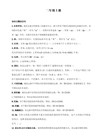
印度税收制度印度税收制度概述印度是南亚次大陆最大的国家,面积297万平方公里,人口近9亿。
印度历史悠久,其税收制度在发展中国家颇具代表性。
一、印度税制的演变印度作为英国的殖民地在各方面都受到英国的影响。
在1960年独立以前,印度经济畸形发展,税制单一,英国盲创的所得税在即度税制中唱独角戏。
独立以后的尼赫鲁政府实行公营与私营的混合经济体制;到60-70年代,公营私营互相渗透,经济的福利性质加强;80年代以来,经济逐步自由化,市场机制得到运用,各方面都处于改革之中。
伴随经济的发展,印度税制也进行着不断的补充与完善。
1953年开征了遗产税,1958年开征了富裕税和赠与税,1962年修改了所得税制,1964年开征了超额利润税。
80年代中后期至现在,印度顺应了世界税制改革浪潮,对其税制也进行不大幅度的改革。
1986年在制造环节实施了一种修改过的增值税制度。
90年代拉奥政府又大张旗鼓地对财税制度进行了新的改革,使印度的税制呈现出新面貌。
二、印度税制的特点(一)中央与地方的分税制体制印度是一个联邦制国家,实行联邦与邦两级预算体制。
与此相适应,在税收上实行联邦和邦两级分税制管理体制。
印度的税收管理权较多地由联邦政府集中掌握,只对各邦授予一定的征税权,因而接近法国式的中央集权分税制。
1935年始印度就将各税种划分为中央税(联邦税)、地方税(各邦税)、共享税三类。
共享税属中央税,是由议会规定按一定的比率划拨给各邦。
随着经济的发展特别是独立以来三个阶段的经济发展,目前这种分税制主要体现为以下内容:l.主要税种的划分。
划属中央税亦即联邦税的税种,系由印度联邦政府依法管理并征收的税种,其中除个别税种划拨给各邦一部分外,其余全部为联邦政府收入。
此类税种按收入大小依次为:关税、联邦税、消费税、个人所得税、公司所得税和富裕税等。
地方税亦即各邦税,是由各邦政府按照被授予权限管理并征收的税种,均为各邦收入。
主要有销售税、各邦消费税、土地税、印花税、客货运输税和娱乐税等。
印度税法体系

二、企业所得税
• 最低替代税MAT(minimum alternative tax)
• 公司的应纳税额低于其账面利润的18.5%, 则应缴纳最低替代税
• MAT与计算的应纳税额差额可在接下来的10 年内从最低替代税额中抵减
• 企业关闭时未全部抵减完的,不退还
二、企业所得税
• 最低替代税MAT(minimum alternative tax)
• 计税基数:收入全额 企业所得税:利润额
• 支付时就从款项中预扣
二、企业所得税
• 预扣所得税(TDS)
• 税率
收入类型
居民企业
非居民企业
永久账号 无永久账号
股息
0
20%
0
利息
10%
20%
20%
支付给承包商的款项 2%
20%
10%
设备/房产租金
2%/10%
20%
40%
技术服务/特许权
10%
20%
10%
2、附加税
净利润金额 0-1000 万卢比 1000 万-1 亿卢比 1 亿卢比-
居民企业 0 7%
12%
非居民企业 0 2% 5%
3、附加教育税 3%
二、企业所得税
• Eg1.某居民企业净利润1500万卢比,则: 所得税及附税= 1500*30%*(1+7%)*(1+3%)
Eg2.某非居民企业净利润1.5亿卢比,则: 所得税及附税= 15000*40%*(1+5%)*(1+3%)
一、印度税法体系
• 行政机构
• 1、印度中央直接税局(Central Board for Direct Taxes, CBDT) ——管理直接税
印度个人所得税优惠政策最详梳理
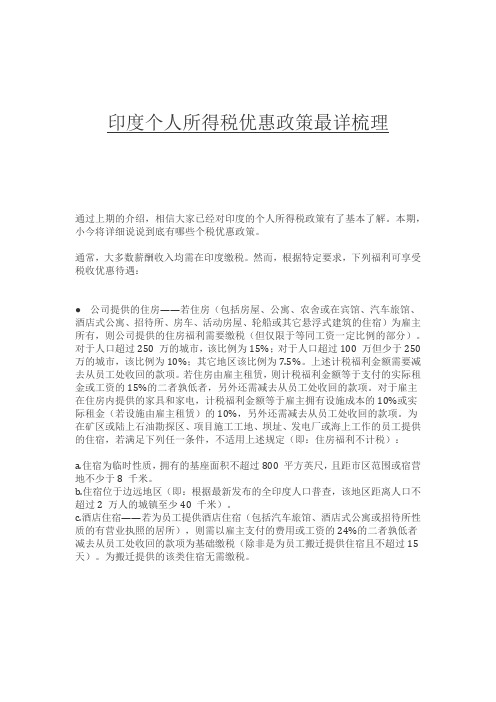
印度个人所得税优惠政策最详梳理通过上期的介绍,相信大家已经对印度的个人所得税政策有了基本了解。
本期,小今将详细说说到底有哪些个税优惠政策。
通常,大多数薪酬收入均需在印度缴税。
然而,根据特定要求,下列福利可享受税收优惠待遇:●公司提供的住房——若住房(包括房屋、公寓、农舍或在宾馆、汽车旅馆、酒店式公寓、招待所、房车、活动房屋、轮船或其它悬浮式建筑的住宿)为雇主所有,则公司提供的住房福利需要缴税(但仅限于等同工资一定比例的部分)。
对于人口超过250 万的城市,该比例为15%;对于人口超过100 万但少于250 万的城市,该比例为10%;其它地区该比例为7.5%。
上述计税福利金额需要减去从员工处收回的款项。
若住房由雇主租赁,则计税福利金额等于支付的实际租金或工资的15%的二者孰低者,另外还需减去从员工处收回的款项。
对于雇主在住房内提供的家具和家电,计税福利金额等于雇主拥有设施成本的10%或实际租金(若设施由雇主租赁)的10%,另外还需减去从员工处收回的款项。
为在矿区或陆上石油勘探区、项目施工工地、坝址、发电厂或海上工作的员工提供的住宿,若满足下列任一条件,不适用上述规定(即:住房福利不计税):a.住宿为临时性质,拥有的基座面积不超过800 平方英尺,且距市区范围或宿营地不少于8 千米。
b.住宿位于边远地区(即:根据最新发布的全印度人口普查,该地区距离人口不超过2 万人的城镇至少40 千米)。
c.酒店住宿——若为员工提供酒店住宿(包括汽车旅馆、酒店式公寓或招待所性质的有营业执照的居所),则需以雇主支付的费用或工资的24%的二者孰低者减去从员工处收回的款项为基础缴税(除非是为员工搬迁提供住宿且不超过15 天)。
为搬迁提供的该类住宿无需缴税。
o●无息或低息贷款——为员工、代表员工的个人或员工家庭成员提供的超过2 万卢比的无息贷款或低息贷款福利需要缴税。
应纳税所得等于尚未还款月份所结余的金额最大值按规定费率计算的名义利息减去从员工收回的利息。
印度税收制度

印度税收制度
印度的税收制度是一个复杂而多层次的体系,分为中央和州两个层面。
以下是该制度的主要方面:
1.直接税:包括个人所得税、公司税和财产税。
个人所得税适
用于个人收入,根据收入水平逐级分档征收。
公司税适用于公司利润,税率相对较高。
财产税适用于个人和公司的财产和资产。
2.间接税:包括货物和服务税(GST)、关税和特别消费税。
货物和服务税是印度税收改革的一部分,于2017年实施,取
代了多种之前的国内税。
关税是对进口和出口商品征收的税费。
3.商品和服务税(GST):GST是一个国家统一的税制,适用
于货物和服务的交易。
以前的多种消费税被废除,换成了一个统一的税率结构。
4.货物和服务税(GST)税率结构:GST税率分为多种层级,
根据货物和服务的性质和重要性进行分类。
税率分为零税率、5%、12%、18%和28%。
5.州税:除了中央税收,印度各个州还有权征收一些特定的税费,如土地转让税、印花税等。
这些税款由各个州政府自行管理和征收。
总体而言,印度的税收制度是一个复杂的体系,旨在为国家提供经济收入,并支持政府的公共服务和社会福利计划。
然而,
该制度也面临一些挑战,如税收逃避和缺乏透明度,这需要进一步的改革和改进。
印度税法(英文)
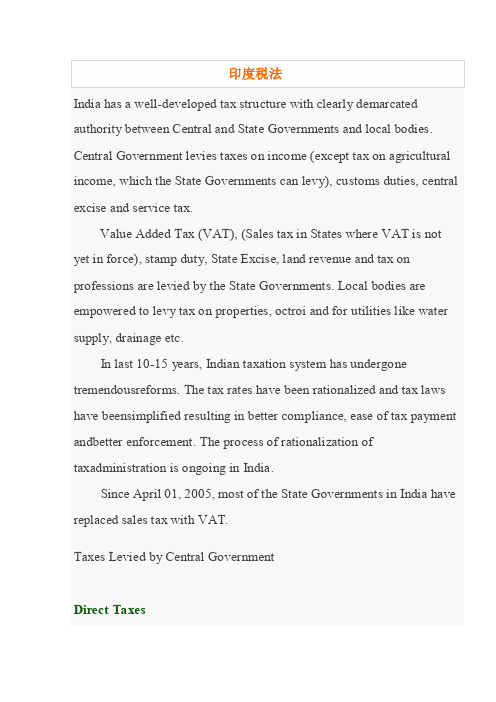
印度税法India has a well-developed tax structure with clearly demarcated authority between Central and State Governments and local bodies. Central Government levies taxes on income (except tax on agricultural income, which the State Governments can levy), customs duties, central excise and service tax.Value Added Tax (VAT), (Sales tax in States where VAT is not yet in force), stamp duty, State Excise, land revenue and tax on professions are levied by the State Governments. Local bodies are empowered to levy tax on properties, octroi and for utilities like water supply, drainage etc.In last 10-15 years, Indian taxation system has undergone tremendousreforms. The tax rates have been rationalized and tax laws have beensimplified resulting in better compliance, ease of tax payment andbetter enforcement. The process of rationalization of taxadministration is ongoing in India.Since April 01, 2005, most of the State Governments in India have replaced sales tax with VAT.Taxes Levied by Central GovernmentDirect Taxes• Tax on Corporate Income• Capital Gains Tax• Personal Income Tax• Tax Incentives• Double Taxation Avoidance TreatyIndirect Taxes• Excise Duty• Customs Duty• Service Tax• Securities Transaction TaxTaxes Levied by State Governments and Local Bodies• Sales Tax/VAT• Other TaxesDirect TaxesTaxes on Corporate IncomeCompanies residents in India are taxed on their worldwide income arising from all sources in accordance with the provisions of the Income Tax Act. Non-resident corporations are essentially taxed on the incomeearned from a business connection in India or from other Indian sources. A corporation is deemed to be resident in India if it is incorporated in India or if it's control and management is situated entirely in India.Domestic corporations are subject to tax at a basic rate of 35% and a 2.5% surcharge. Foreign corporations have a basic tax rate of 40% and a 2.5% surcharge. In addition, an education cess at the rate of 2% on the tax payable is also charged. Corporates are subject to wealth tax at the rate of 1%, if the net wealth exceeds Rs.1.5 mn ( appox. $ 33333).Domestic corporations have to pay dividend distribution tax at the rate of 12.5%, however, such dividends received are exempt in the hands of recipients.Corporations also have to pay for Minimum Alternative Tax at 7.5% (plus surcharge and education cess) of book profit as tax, if the tax payable as per regular tax provisions is less than 7.5% of its book profits.Following measures were taken in the union budget 2007-08Surcharge on income tax on all firms and companies with a taxable income of Rs.1 crore or less to be removed.A five year income tax holiday for two, three or four star hotels and for convention centres with a seating capacity of not less than 3,000; they should be completed and begin operations in National Capital Territory of Delhi or in the adjacent districts of Faridabad, Gurgaon, Ghaziabad or Gautam Budh Nagar during April 1, 2007 to March 31, 2010.Concession under section 35(2AB) to be extended for five more years until March 31, 2012.Tax holiday to undertakings in Jammu & Kashmir to be extended for another five years up to March 31, 2012.Minimum Alternate Tax (MAT) to be extended to income in respect of which deduction is claimed under sections 10A and 10B; deduction under section 36(1) (viii) to be restricted to 20% of profits each year.Rate of dividend distribution tax to be raised from 12.5% to 15% on dividends distributed by companies; and to 25% on dividends paid by money market mutual funds and liquid mutual funds to all investors.Expenditure on free samples and on displays to be excluded from the scope of Fringe Benefit Tax (FBT); ESOPs to be brought under FBT.An additional cess of 1% on all taxes to be levied to fund secondary education and higher education and the expansion of capacity by 54% for reservation for socially and educationally backward classes.http://indiabudget.nic.in/ub2007-08/high.htmFor further details please visit the web site of Income Tax Department at.in/TopCapital Gains TaxTax is payable on capital gains on sale of assets.Long-term Capital Gains Tax is charged if• Capital assets are held for more than three years and• In case of shares, securities listed on a recognized stock exchange in India, units of specified mutual funds, the period for holding is oneyear.Long-term capital gains are taxed at a basic rate of 20%. However, long-term capital gain from sale of equity shares or units of mutual funds are exempt from tax.Short-term capital gains are taxed at the normal corporate income tax rates. Short-term capital gains arising on the transfer of equity shares or units of mutual funds are taxed at a rate of 10%.Long-term and short-term capital losses are allowed to be carried forward for eight consecutive years. Long-term capital losses may be offset against taxable long-term capital gains and short-term capital losses may be offset against both long term and short-term taxable capital gains.For further details please visit the web site of Income Tax Department at.in/Personal Income taxPersonal income tax is levied by Central Government and is administered by Central Board of Direct taxes under Ministry of Finance in accordance with the provisions of the Income Tax Act. The rates for personal income tax are as follows:-Income range (Rupee) Tax Rate (%)0-100,000 Nil1,00,000-1,50,000 101,50,000-2,50,000 202,50,000 and above 30Surcharges of 10% on total tax is levied if income exceeds Rs. 8,50,000Recent budget initiatives in this regard are as follows:Threshold limit of exemption in the case of all assessees to be increased by Rs.10,000 thus giving every assessee a relief of Rs.1,000; in the case of a woman assessee, threshold limit to be increased from Rs.135,000 to Rs.145,000 and in case of a senior citizen from Rs.185,000 toRs.195,000 giving him or her a relief of Rs.2,000; deduction in respectof medical insurance premium under section 80D to be increased to a maximum of Rs.15,000 and, in case of a senior citizen, a maximum of Rs.20,000.Rates of Withholding TaxCurrent rates for withholding tax for payment to non-residents are:-(i) Interest 20%(ii) Dividends Dividends paid by domestic companies: Nil(iii) Royalties 10%(iv) Technical Services 10%(v) Any other services Individuals: 30% of the income Companies: 40% of the net incomeThe above rates are general and are applicable in respect of countries with which India does not have a Double Taxation Avoidance Agreement (DTAA).For further details please visit the web site of Income Tax Department at.in/Tax IncentivesGovernment of India provides tax incentives for:-• Corporate profit• A ccelerated depreciation allowance• Deductibility of certain expenses subject to certain conditions.These tax incentives are, subject to specified conditions, available for new investment in• Infrastructure,• Power distribution,• Certain telecom s ervices,• Undertakings developing or operating industrial parks or special economic zones,• Production or refining of mineral oil,• Companies carrying on R&D,• Developing housing projects,• Undertakings in certain hill states,• Handling of food grains,• Food processing,• Rural hospitals etc.For further details please visit the web site of Income Tax Department at.in/Double Tax Avoidance TreatyIndia has entered into DTAA with 65 countries including the US. In case of countries with which India has Double tax Avoidance Agreement, the tax rates are determined by such agreements. Domestic corporations are granted credit on foreign tax paid by them, while calculating tax liability in India.In the case of the US, dividends are taxed at 20%, interest income at 15% and royalties at 15%.For further details please visit the web site of Income Tax Department at/TaxmannDit/IntTax/Dtaa.aspxTop Indirect TaxesExcise DutyManufacture of goods in India attracts Excise Duty under the Central Excise act 1944 and the Central Excise Tariff Act 1985. Herein, the term Manufacture means bringing into existence a new article having a distinct name, character, use and marketability and includes packing, labeling etc.Most of the products attract excise duties at the rate of 16%. Some products also attract special excise duty/and an additional duty of excise at the rate of 8% above the 16% excise duty. 2% education cess is also applicable on the aggregate of the duties of excise. Excise duty is levied on ad valorem basis or based on the maximum retail price in some cases.Recent budget initiatives in this regard are as follows:Reduction in ad valorem component of excise duty on petrol and diesel from 8% to 6%.Relief to deserving cases especially job creating sectors: exemptionlimit for small scale industry (SSI) to be raised from Rs.1 crore toRs.1.5 crore; to encourage food processing sector, biscuits whose retail sale price does not exceed Rs.50 per kilogram and all kinds of food mixes including instant mixes to be fully exempt; reduction in duty on umbrellas and parts offootwear from 16% to 8%; on plywood from 16% to 8%; biodiesel to be fully exempt.To provide access to pure drinking water, water purification devices operating on specified membrane based technologies and domestic water filters not using electricity to be fully exempt; exemption on pipes used for carrying water from a water supply plant to a storage facility to be extended to all pipes of diameter exceeding 200 mm used in water supply systems.Reduction in the rate of duty from Rs.400 per metric tonne to Rs.350 per metric tonne on cement sold in retail at not more than Rs.190 per bag; rate of Rs.600 per metric tonne on cement that has a higher MRP.Specific rates of duty on cigarettes to be increased by about 5%; duty (excluding cess) on biris to be raised from Rs.7 to Rs.11 per thousand for non-machine made biris and from Rs.17 to Rs.24 per thousand formachine made biris; duty on pan masala not containing tobacco to be reduced from 66% to 45%; withdrawal of exemption for pan masala containing tobacco and other tobacco products given to units in the North Eastern States.Central Excise duty is administered by the Central Board of Excise and Customs. For further information, please visit their website at.in/Excise Tariffs - Central Excise Tariff Act 2005.in/excise/cx-tariff0708/cxt0708-idx.htmCentral Excise Manual.in/excise/cx-manual/manual/index1.htmThe Central Excise Act 1944.in/excise/cx-act/cx-act-idx.ht mFAQ .in/faq.htmCustoms DutyThe levy and the rate of customs duty in India are governed by the Customs Act 1962 and the Customs Tariff Act 1975. Imported goods in India attract basic customs duty, additional customs duty and education cess. The rates of basic customs duty are specified under the Tariff Act. The peak rate of basic customs duty has been reduced to 15% for industrial goods. Additional customs duty is equivalent to the excise duty payable on similar goods manufactured in India. Education cess at 2% is leviable on the aggregate of customs duty on imported goods. Customs duty is calculated on the transaction value of the goods.Rates of customs duty for goods imported from countries with whom India has entered into free trade agreements such as Thailand, Sri Lanka, BIMSTEC, south Asian countries and MERCOSUR countries are provided on the website of CBEC.Customs duties in India are administrated by Central Board of Excise and Customs under Ministry of Finance.Recent budget initiatives in this regard are as follows:Customs duties:Reduction in peak rate for non-agricultural products from 12.5% to 10%.Reduction in duty on most chemicals and plastics from 12.5% to 7.5%; on seconds and defectives of steel from 20% to 10%.All coking coal irrespective of ash content to be fully exempt.Reduction in duty on polyester fibres and yarns from 10% to 7.5% and on raw-materials such as DMT, PTA and MEG from 10% to 7.5%; on cut and polished diamonds from 5% to 3%; on rough synthetic stones from 12.5% to 5%; and on unworked corals from 30% to 10%.Dredgers to be fully exempt from import duty.To augment irrigation facilities and processing of agricultural products, reduction in duty on drip irrigation systems, agricultural sprinklers and food processing machinery from 7.5% to 5%.Reduction in general rate of import duty on medical equipment to 7.5%.To make edible oils more affordable, crude and refined edible oils to be exempt from additional CV duty of 4%; reduction in duty on sunflower oil, both crude and refined, by 15 percentage points.Reduction in duty on pet foods from 30% to 20%; on watch dials and movements and umbrella parts from 12.5% to 5%; to promote research and development, concessional rate of 5% duty to be extended to all research institutions registered with the Directorate of Scientific and Industrial Research; reduction in duty from 7.5% to 5% on 15 specified machinery for pharmaceutical and biotechnology sector.Duty of 3% (WTO bound rate) to be levied on all private import of aircraft including helicopters; such import to also attract countervailing duty andadditional customs duty.Duty of Rs.300 per metric tonne to be levied on export of iron ores and concentrates and Rs.2,000 per metric tonne on export of chrome ores and concentrates.TopSchedule of Customs duties- The Customs Tariff Act 2005.in/customs/cst-0708/cst-main.htmWebsite of Central Board of Excise and Customs.in/The Customs Act 1962.in/customs/cs-act/cs-act-idx.htmCustoms Manual.in/customs/cs-manual/manual_idx.htmBaggage Rules 1998.in/customs/cs-act/formatted-htmls/cs-rulef.htm FAQ .in/faq.htmService TaxService tax is levied at the rate of 10% (plus 2% education cess) oncertain identified taxable services provided in India by specified service providers. Service tax on taxable services rendered in India are exempt, if payment for such services is received in convertible foreign exchange in India and the same is not repatriated outside India. The Cenvat Credit Rules allow a service provider to avail and utilize the credit of additional duty of customs/excise duty for payment of service tax. Credit is also provided on payment of service tax on input services for the discharge of output service tax liability.Recent budget initiatives in this regard are as follows:Exemption limit for small service providers to be raised fromRs.400,000to Rs.800,000.Extension of service tax to: services outsourced for mining of mineral, oil or gas; renting of immovable property for use in commerce or business (residential properties, vacant land used for agriculture and similar purposes, and land for sports, entertainment and parking purposes & immovable property for educational or religious purposes to be excluded); developmentand supply of content for use in telecom and advertising purposes; assetmanagement services provided by individuals; design services; services involved in execution of a works contract with an optional composition scheme under which tax will be levied at only 2% of the total value of works contract.Exemption to: Services provided by Resident Welfare Associations to their members who contribute Rs.3000 or less per month for services rendered, services provided by technology business incubators, their incubatees whose annual business turnover does not exceed Rs.50 lakhs to be exempt for first three years; clinical trial of new drugs to make India a preferred destination for drug testing.Department of Telecommunications to constitute a committee to study the present structure of levies on telecom industry.Website of Central Board of Excise and Customs relating to Service Tax .in/FAQ .in/faq.htmSecurities Transaction TaxTransactions in equity shares, derivatives and units of equity-oriented funds entered in a recognized stock exchange attract Securities Transaction Tax at the following rate:-• Delivery base transactions in equity shares or buyer and sellereach units of an equity-oriented fund - 0.075%• Sale of units of an equity-oriented fund to the seller mutual fund - 0.15%• Non delivery base transactions in the above - 0.015%• Derivatives (futures and options) seller - 0.01%For further details please visit the web site of Income Tax Department at .in/TopSales Tax Acts of various State Governments and Central Sales Act governed the application of Sales Tax/VAT.Sales Tax/VATSales tax is levied on the sale of movable goods. Most of the Indian States have replaced Sales tax with a new Value Added Tax (VAT) from April 01, 2005. VAT is imposed on goods only and not services and it has replaced sales tax. Other indirect taxes such as excise duty, service tax etc., are not replaced by VAT. VAT is implemented at the State level by State Governments. VAT is applied on each stage of sale with a mechanism of credit for the input VAT paid. There are four slabs of VAT:-• 0% for essential commodities• 1% on bullion and precious stones• 4% on industrial inputs and capital goods and items of mass consumption• All other items 12.5%• Petroleum products, tobacco, liquor e tc., attract higher VAT rates that vary from State to StateA Central Sales Tax at the rate of 4% is also levied on inter-State sales and would be eliminated gradually.Municipal/Local Taxes• Octori/entry tax: - Some municipal jurisdictions levy octori/entry tax on entry of goodsOther State Taxes• Stamp duty on transfer of assets• Property/building tax levied by local bodies• Agriculture income tax levied by State Governments on income from plantations• Luxury tax levied by certain State Govern ment on specified goods印度税法印度有一个明确划分中央与州政府和地方机构的权力发达的税收结构。
印度《1975年关税法》

印度《1975年关税法》第九A条:对倾销货物征收反倾销税1、如果任何国家或地区(以下在本条中简称为“出口国或地区”)以不足正常价格一半的价格向印度出口任何货物,则在此类货物进口印度时,中央政府可在“官方文告”中发布通知,对此类货物征收数额不超过其倾销差额的反倾销税。
释义:在本条中:(1)“倾销差额”,对于某种货物而言,是指其出口价格与其正常价格之间的差额;(2)“出口价格”,对于某种货物而言,是指这一货物自出口国或地区出口时的价格。
如果这一货物没有出口价格,或由于出口商与进口商或第三方之间的联合或补偿性安排,致使这一出口价格不具有可信度,则出口价格可根据该项货物进口后首次售与独立买方的价格予以确定。
如果该项货物没有售与独立的买方,或者未以进口时的相同条件出售,则出口价格可根据第6款项下制定的细则予以合理确定;(3)“正常价格”,对于某种货物而言,是指:(i)依据第6款项下制定的细则所确定的,在正常贸易过程中,在出口国或地区用于消费的类似货物的可比价格;或(ii)如果出口国或地区在其正常贸易过程中并未在国内市场上出售类似的货物,或者由于出口国或地区特定的市场情况、或其国内市场的销量较低,因此这一销量无法进行有效的比较,则正常价格应根据以下因素来决定:(a)依据第6款项下制定的细则所确定的,由出口国、地区或合适的第三方出口类似货物的可比代表性价格;或(b)依据第6款项下制定的细则所确定的,该货物在原产地国的生产成本,加合理的管理、销售和一般性成本,以及货物的利润;但是,如果货物是从原产地国以外的其他国家进口,而且该货物只是从出口国进行转运,或该货物不是在出口国生产,或在货物的出口国不存在可比价格,则正常价格应参照货物原产地国家的价格来确定。
2、在依据本条规定和本条项下制定的细则确定货物的正常价格和倾销差额的过程中,中央政府可根据其临时确定的此类货物的价格和倾销差额,对进口印度的此类货物征收反倾销关税。
印度税收制度简介
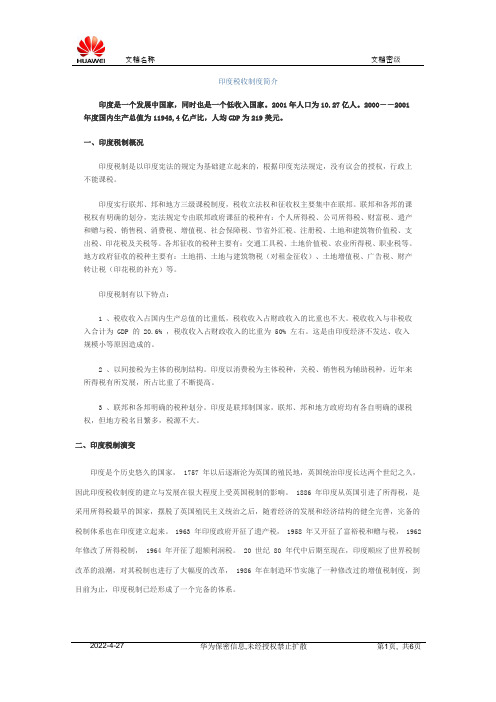
印度税收制度简介印度是一个发展中国家,同时也是一个低收入国家。
2001年人口为10.27亿人。
2000――2001年度国内生产总值为11943,4亿卢比,人均GDP为219美元。
一、印度税制概况印度税制是以印度宪法的规定为基础建立起来的,根据印度宪法规定,没有议会的授权,行政上不能课税。
印度实行联邦、邦和地方三级课税制度,税收立法权和征收权主要集中在联邦。
联邦和各邦的课税权有明确的划分,宪法规定专由联邦政府课征的税种有:个人所得税、公司所得税、财富税、遗产和赠与税、销售税、消费税、增值税、社会保障税、节省外汇税、注册税、土地和建筑物价值税、支出税、印花税及关税等。
各邦征收的税种主要有:交通工具税、土地价值税、农业所得税、职业税等。
地方政府征收的税种主要有:土地捐、土地与建筑物税(对租金征收)、土地增值税、广告税、财产转让税(印花税的补充)等。
印度税制有以下特点:1 、税收收入占国内生产总值的比重低,税收收入占财政收入的比重也不大。
税收收入与非税收入合计为 GDP 的 20.6% ,税收收入占财政收入的比重为 50% 左右。
这是由印度经济不发达、收入规模小等原因造成的。
2 、以间接税为主体的税制结构。
印度以消费税为主体税种,关税、销售税为辅助税种,近年来所得税有所发展,所占比重了不断提高。
3 、联邦和各邦明确的税种划分。
印度是联邦制国家,联邦、邦和地方政府均有各自明确的课税权,但地方税名目繁多,税源不大。
二、印度税制演变印度是个历史悠久的国家, 1757 年以后逐渐沦为英国的殖民地,英国统治印度长达两个世纪之久,因此印度税收制度的建立与发展在很大程度上受英国税制的影响。
1886 年印度从英国引进了所得税,是采用所得税最早的国家,摆脱了英国殖民主义统治之后,随着经济的发展和经济结构的健全完善,完备的税制体系也在印度建立起来。
1963 年印度政府开征了遗产税, 1958 年又开征了富裕税和赠与税, 1962 年修改了所得税制, 1964 年开征了超额利润税。
印服装商建议将折旧率提高到50%

印服装商建议将折旧率提高到50%
印度蒂鲁普出口商协会的会长萨科斯维尔在致印度政府的预算备忘录的信中说,由于印度的针织行业面临严峻的海外竞争,他们的技术要求频繁的更新,因此他们提出了更高的折旧率的要求。
蒂鲁普出口商协会建议将折旧率从目前的15%提高到50%,这样服装工业能够有效的迎接来自于其他国家的出口商的竞争。
萨科斯维尔说,印度政府允许在10月份之前的投资折旧率提取20%,但是在第一年,只允许提取10%的折旧率,剩下的10%将结转到下一年。
服装工业能够提供每年最低200天的工作天数,这样政府应当将此包括在就业担保计划当中。
萨科斯维尔说,服装工业能够产生500万个就业计划,日工资收入为70卢比。
萨科斯维尔建议,那些工资支出比前一年高25%的服装单位应当得到应有的所得税评估。
印度的服装工业已经向政府提出了削减人造纤维和纱线的消费税的建议,同棉纱保持在同一水平,这是为了增加合成纤维在布料中的应用含量。
这将对生产非棉服装提供帮助,拓宽出口。
- 1、下载文档前请自行甄别文档内容的完整性,平台不提供额外的编辑、内容补充、找答案等附加服务。
- 2、"仅部分预览"的文档,不可在线预览部分如存在完整性等问题,可反馈申请退款(可完整预览的文档不适用该条件!)。
- 3、如文档侵犯您的权益,请联系客服反馈,我们会尽快为您处理(人工客服工作时间:9:00-18:30)。
Depreciation
Depreciable assets are grouped in blocks, and each block is eligible for depreciation at a prescribed rate (usually 15% to 100% for machinery, 5% to 100% for buildings, 10% for furniture, and 25% for intangible assets) on the opening value (net of depreciation charged in preceding years), plus cost of acquisition, less deletions, during the year. A deletion is the reduction by way of sale, discarding, demolition, or destruction of the assets and the amount realised is reduced.
Depreciation is restricted to 50% of the prescribed rate if the asset acquired is used for less than 180 days during the year of acquisition. If money receivable on the transfer exceeds the opening written-down value plus acquisitions of the block concerned, the excess is taxed as a short-term capital gain at the same tax rates as that applicable to business income.
Additional depreciation of 20% on the cost of new plant and machinery (other than ships or aircrafts) is allowable in the year of commissioning for manufacture.
Power-generating or power-distributing companies have the option either to apply the reducing balance method provided under the normal schedule or to charge depreciation on a straight-line basis. The straight-line rates are aligned to the power companies’ book depreciation rates.
Know-how, patents, licenses, franchises, and similar intangible assets form part of the block of depreciable assets, provided that they are owned and put to use in the course of their business and are eligible for depreciation at the prescribed rate, which is 25%.
Tax depreciation is not required to conform to book depreciation.。
